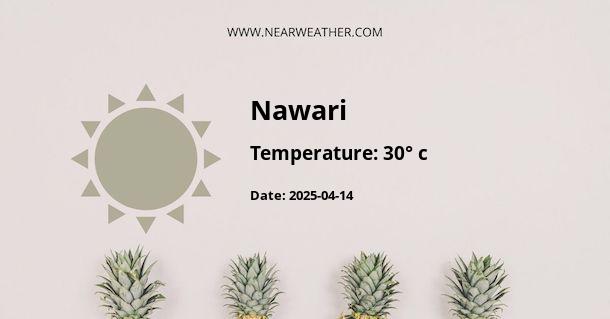Nawari, Ghana: Climate and Weather Year Round
Nawari, located in Ghana, experiences a tropical savanna climate, characterized by distinct wet and dry seasons throughout the year. This unique climate contributes to the diverse vegetation and wildlife found in the region. Understanding the climate and weather patterns in Nawari is essential for residents, tourists, and researchers alike.
Temperature
The temperature in Nawari remains relatively high throughout the year due to its proximity to the equator. Average temperatures range between 25°C (77°F) and 35°C (95°F). The hottest months are typically between December and March, with temperatures occasionally reaching 40°C (104°F) during the day. The coolest months are between June and August, with temperatures dropping to around 20°C (68°F) at night.
The table below provides a monthly breakdown of the average temperatures in Nawari:
| Month | Average Temperature (°C) |
|---|---|
| January | 32 |
| February | 33 |
| March | 34 |
| April | 33 |
| May | 31 |
| June | 29 |
| July | 28 |
| August | 28 |
| September | 29 |
| October | 30 |
| November | 31 |
| December | 32 |
Rainfall
Nawari experiences a distinct wet season and dry season. The wet season lasts from April to October, while the dry season spans from November to March. The region receives the majority of its annual rainfall during the wet season, with precipitation levels reaching their peak between June and September.
The table below presents the average monthly rainfall in Nawari:
| Month | Average Rainfall (mm) |
|---|---|
| January | 10 |
| February | 20 |
| March | 40 |
| April | 90 |
| May | 120 |
| June | 180 |
| July | 200 |
| August | 180 |
| September | 160 |
| October | 100 |
| November | 30 |
| December | 10 |
Humidity
Due to its tropical climate, Nawari experiences high humidity levels year-round. Humidity levels typically range between 70% and 90%. The combination of high temperatures and humidity can make the weather feel even hotter, especially during the wet season.
Wind Patterns
The prevailing wind patterns in Nawari are influenced by the movement of the Intertropical Convergence Zone (ITCZ). During the wet season, the ITCZ moves northward, bringing moist air from the Gulf of Guinea. This results in increased cloud cover and precipitation. In contrast, during the dry season, the ITCZ moves southward, causing a decrease in rainfall and drier conditions.
Vegetation and Wildlife
The climate in Nawari supports a diverse range of vegetation and wildlife. The wet season provides ample rainfall, allowing for the growth of lush vegetation, including tall grasses, shrubs, and trees. This vegetation, in turn, supports a variety of animal species, including elephants, antelopes, monkeys, and various bird species.
Conclusion
Nawari, Ghana experiences a tropical savanna climate with distinct wet and dry seasons. The temperature remains high throughout the year, with the hottest months between December and March. The region receives the majority of its rainfall between April and October, with peak precipitation occurring between June and September. The combination of high temperatures and humidity contributes to the unique vegetation and wildlife found in the area. Understanding the climate and weather patterns in Nawari is crucial for residents, tourists, and researchers alike.
A - Nawari's Latitude is 10.216670 & Longitude is 0.266670.
A - Weather in Nawari is 30° today.
A - Climate Conditions in Nawari shows overcast clouds today.
A - Humidity in Nawari is 45% today.
A - Wind speed in Nawari is 8.64 km/h, flowing at 205° wind direction. today.
